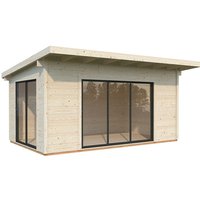Sheds Bases for Sale in UK
Shed bases are the unsung heroes of garden structures, providing the essential support and stability for your shed. Discover the variety of options, from concrete to gravel, and learn how to choose the perfect base for your needs. Explore the advantages and unique features of each type, ensuring your shed stands strong and secure.
The Foundation of Stability: Understanding the Importance of Shed Bases
A shed base is more than just a patch of ground; it’s the foundation that ensures your shed remains upright and functional for years to come. A well-crafted base prevents moisture ingress, provides a level surface, and enhances the longevity of your shed. Without a proper base, even the most robust shed can succumb to structural issues.
Concrete Bases: The Rock-Solid Choice
For those seeking durability and permanence, concrete bases are a popular choice. They offer a solid, level surface that withstands heavy loads and adverse weather conditions. While the installation requires more effort and expertise, the result is a long-lasting foundation that provides unparalleled stability.
Paving Slabs: Versatile and Aesthetic Appeal
Paving slabs offer a flexible and visually appealing alternative. They are relatively easy to install and can be arranged to fit the dimensions of your shed perfectly. This type of base allows for drainage between slabs, reducing the risk of water damage. The aesthetic variety of paving slabs also means you can blend your shed seamlessly into your garden’s design.
Timber Framed Bases: Lightweight and Environmentally Friendly
If you’re looking for an eco-friendly option, consider a timber framed base. These bases are constructed using treated timber that’s resistant to rot and decay. They are lightweight, making them suitable for less robust ground conditions, and offer a natural look that complements wooden sheds beautifully. However, they may require more maintenance compared to concrete or paving slab bases.
Gravel Bases: Cost-Effective and Easy to Install
Gravel bases are a cost-effective solution for those who prefer a straightforward installation process. Gravel allows for excellent drainage, which is crucial for preventing moisture buildup under the shed. This type of base is ideal for flat ground and can be easily adjusted or expanded if needed. However, it may not provide the same level of stability as more permanent options.
Plastic Grid Systems: Innovative and Sustainable
The modern choice for shed bases, plastic grid systems combine innovation with sustainability. Made from recycled materials, these grids are easy to assemble and provide a stable, permeable surface. They are particularly useful for uneven terrains and can be filled with gravel or soil to blend with the garden environment. Their lightweight nature makes them easy to transport and install without heavy machinery.
Comparing the Options: Choosing the Right Base for Your Shed
Each type of shed base comes with its unique advantages and considerations. When selecting the right base, consider factors such as ground conditions, shed size, budget, and personal preferences. Concrete bases offer robustness, while timber frames provide a natural aesthetic. Paving slabs combine versatility with style, while gravel bases offer simplicity and cost-effectiveness. Plastic grid systems, on the other hand, present an eco-friendly, innovative solution.
Installation Tips for a Perfect Shed Base
Regardless of the type of base you choose, proper installation is key to ensuring its effectiveness. Start by clearing the area of vegetation and debris. For concrete bases, ensure a level pour and sufficient curing time. When using paving slabs, check for even spacing and stability. For timber and plastic bases, verify all components are securely fitted. Finally, for gravel bases, ensure an even distribution and compact the gravel to create a stable surface.
Enhancing Longevity: Maintenance Considerations for Shed Bases
While shed bases require minimal upkeep, regular checks can enhance their longevity. Inspect concrete and paving slabs for cracks or shifts. For timber bases, look for signs of rot and treat the wood as necessary. Ensure gravel bases remain level and free from excessive weeds. For plastic grid systems, periodically check for any displaced sections and refill with gravel as needed.
Conclusion: The Unsung Hero of Your Garden Shed
A well-chosen and properly installed shed base is crucial for the functionality and durability of your shed. By understanding the different types of bases and their unique benefits, you can make an informed decision that suits your needs and enhances your garden’s aesthetics. Whether you opt for the permanence of concrete, the versatility of paving slabs, or the innovation of plastic grids, your shed base will be the steadfast support your garden structure needs.
